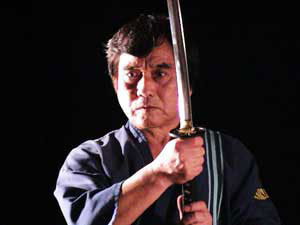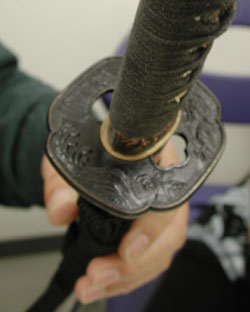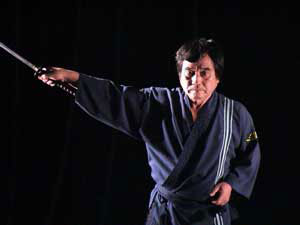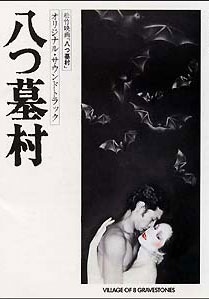Samurai Screams
The Sword Series > Samarai Screams > Sword Polishing
When he was nosed out by Tom Cruise for the lead in "Last Samurai," the Captain, unbowed, remarked: "I shall return." Wait a second, it could have been: "The pen is mightier than the sword." In any case, it was something pretty damn insightful.
 This week the Captain is finally bringing those bushido dreams to life by visiting a school that teaches sword-fight choreography for movie and stage scenes.
This week the Captain is finally bringing those bushido dreams to life by visiting a school that teaches sword-fight choreography for movie and stage scenes.
"Ahhhhhhhhhhhhh!"
A loud scream is vital just before you are about to have your belly sliced open.
With your sword raised above your head, you then attack. Your opponent, legs slightly bent at the knees, brings his sword horizontally across your gut as you lunge at him. He is careful to slide the sword along your midsection and not swing it. After all, this is not baseball.
"You are being killed. You need to scream!" booms instructor Ryuji Kikuchi of the Tate-Do school of sword-fight choreography.
You hunch over clutching your stomach and once again let out another roar.
Your opponent quickly returns his weapon to the sheath attached to his belt. As is the custom, you then fall to the floor once it is securely in place. You are now dead.
From Kurosawa to kabuki, these have been the basics for killing and being killed in Japanese sword-fight choreography.
 "When we were children and played with sticks to imitate samurai," he explains, "we did it because we saw it in the movies. But average people couldn't learn the techniques properly because it was only for professionals."
"When we were children and played with sticks to imitate samurai," he explains, "we did it because we saw it in the movies. But average people couldn't learn the techniques properly because it was only for professionals."
Now they can.
Though Kikuchi has a long resume of giving instructions for fight scenes in movies and plays, the Tate-Do school is aimed at amateurs who want to sharpen their samurai spirit and let off a little steam.
Tate is the term for sword-fight choreography. Adding do is the work of Kikuchi; he wants it to be seen as a respected art form in the same way as sado (the way of tea) or kendo.
Dressed in street clothes or more traditional hakama (robes), seventy students manipulate practice swords and develop footwork techniques twice a week at branches in Tokyo and Osaka for 2,500 yen a lesson.
"The most important part is the screaming," says Kikuchi during a break between classes. "The timing is vital and the voice needs to come from deep within the stomach. This is also good for your health as a means of stress relief."
Grouped into pairs or threesomes, the students alternately run at one another, slicing, chopping, and shouting, just like warriors in the movies. Kikuchi circulates about the room like a drill sergeant, continually emphasizing feet position and weight control when working the weapon. Of course, all defeated warriors wait for their opponents to return their blades to their sheaths before collapsing to the hardwood floor - it is the only ending accepted in the business.
Knowing when to stop the blade is not to be overlooked. Halting the weapon in a sudden, crisp fashion is done by concentrating on the direction of the force.
 "If she does that she'll cut her leg," Kikuchi instructs to the entire class of one female student who moved her leg forward too far. "She is only using her arms. Use your hips. Use your weight to direct the sword downward."
"If she does that she'll cut her leg," Kikuchi instructs to the entire class of one female student who moved her leg forward too far. "She is only using her arms. Use your hips. Use your weight to direct the sword downward."
Kikuchi, who even at the age of sixty-eight punctuates many of his more emphatic comments with a thrust of a clenched fist or the release of an onomotopaeic samurai growl, got his start in the business doing stunt work with studio Nikkatsu 40 years ago. Kikuchi fell down stairs and rolled down hills, which, he explains, was "no practice and all courage."
A few years later Kikuchi found himself at Nippon Television performing in live dramas after Yomiuri Giants games finished. "The hardest part was waiting," he remembers. "But getting paid in cash while still in costume afterwards was the greatest."
It was some years later under the tutelage of Makino Masahiro, the legendary director of heroic epics whose characters often had an obsequious desire for the triumph of justice, that Kikuchi first learned fight-scene choreography - the skill that eventually weened him from being a full-time actor.
The practice of tate dates back hundreds of years, to the days of the kabuki theater when it was called tatchimawari. The name evolved with the advent of movies.
Kikuchi's movie credits include Hideo Gosha's "Kagerou," an action picture centered on a complicated relationship between a yakuza and a female gambler, and Takeshi Kitano's directorial debut "Sono Otoko Kyobo Ni Tsuki" (Violent Cop), a gangster tale featuring corrupt cops and one man on a mission of revenge. In the Kansai area, Kikuchi has staged various fight sequences for performances at the Shinkabukiza and Umeda Koma theaters.
Given tight shooting schedules, time is almost always of the essence. But sometimes training an actor to properly use a sword can take a few weeks. Even then the results in the studio might not be as great as hoped. "Yatsu Haka-Mura" (The Village of Eight Gravestones) was a case in point.
 Released in 1977, the story revolves around a family curse and eight samurai who must be killed. Kikuchi's task was to create different ways for each to die. In one case, Kikuchi inserted pork meat and a phony bladder of blood above an iron plate set between the actor's chest and his samurai costume. Getting the killer to pierce the cloth with a sickle so that the props resembled mangled human flesh was tiresome and time-consuming.
Released in 1977, the story revolves around a family curse and eight samurai who must be killed. Kikuchi's task was to create different ways for each to die. In one case, Kikuchi inserted pork meat and a phony bladder of blood above an iron plate set between the actor's chest and his samurai costume. Getting the killer to pierce the cloth with a sickle so that the props resembled mangled human flesh was tiresome and time-consuming.
"I used a lot of pork meat," Kikuchi laughs.
Even though there are no sharp edges on the bokuto (wooden swords) and the blades of the steel type are heavily taped, accidents are all a part of it. Wrist injuries, cuts above the nose, swollen eye sockets, and broken bones are very common.
Aside from spreading tate as a cultural treasure, another motivation for Kikuchi is the lack of direction he sees in today's arts. Computer graphics are increasingly being used in movies to enhance fight scenes, something Kikuchi completely despises. This year's ninja action flick "Shinobi" (Heart Under Blade) is one example.
"The stories used to be about humanity," he says. "The human relationships were the main attraction. Now everything is superficial. They have lost the most important part - what's inside."
Kikuchi sees his school as a way of peering into that inner area that is often overlooked.
"Tate has a lot within it," he says. "More and more, the young generation is losing its interest in Japanese history. But by learning tate techniques, they can get in touch with Japanese culture."
Note: More information on Tate-Do can be found on their Web page.
The Sword Series > Samarai Screams > Sword Polishing

